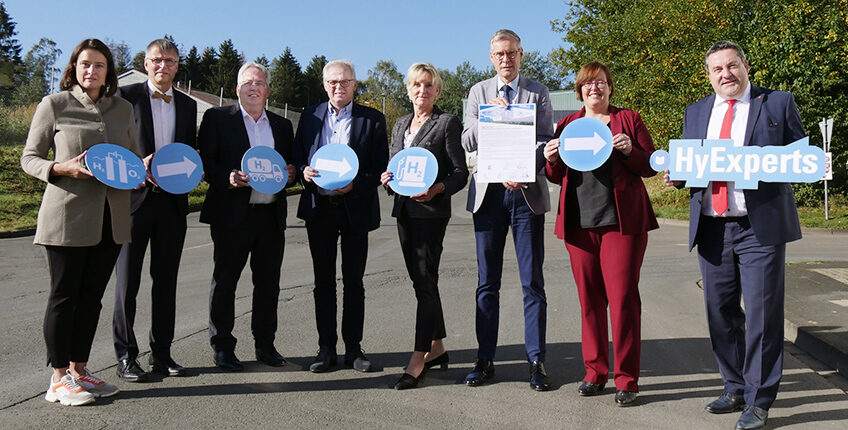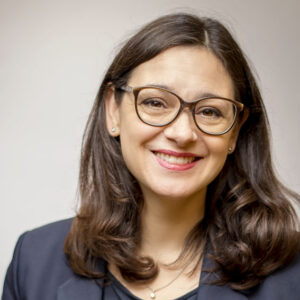East Westphalia-Lippe (OWL – Ostwestfalen-Lippe) is a good hydrogen region candidate – this is the conclusion of the “HyDrive OWL” project. During the potential analysis, the districts of Lippe and Minden-Lübbecke as well as the city of Bielefeld, together with the Fraunhofer Institute for Solar Energy Systems (Fraunhofer ISE), examined the prerequisites for local production, distribution and use.
All other districts in OWL were also involved in the evaluation of the user potential. “During the joint OWL climate campaign, we emphasised that we want to be pioneers in climate protection in NRW. By involving the entire region in the topic of hydrogen, we are sending out a strong initial signal. Especially because we are thinking outside the box and not only focusing on the mobility transition, but also looking into opportunities for a ‘clean’ industry,” explained Axel Lehmann, District Administrator of the Lippe district.
Results of the potential analysis
In principle, the analysis by Fraunhofer ISE has shown that a first electrolysis plant for the production of hydrogen is primarily economical once a certain scale is reached. For OWL, this means that a facility should have a capacity of up to 10 MW and 8,000 full-load hours per year in order to achieve competitive production costs. Among the sites considered in the OWL area, the best performance is achieved by the waste incineration plant in Bielefeld. “The plant is favoured in the concept because it meets all the essential criteria. In addition to the generation potential, the main factor is the willingness for expanding a production site here. The infrastructural conditions are also optimal. This means that the first hydrogen for the region could potentially be produced in Bielefeld,” explains Pit Clausen, Lord Mayor of Bielefeld.
Similar to conventional fuel, the hydrogen is to be transported to the individual collection points by special vehicles. These could be operated by an external company, for instance. At present, there are no plans to feed hydrogen into the gas grid, for economic reasons. The concept envisages one filling station per region. Each of these should be located at a convenient location, such as the A33/A44 motorway junction in Paderborn or the A2/A30 motorway junction in Bad Oeynhausen, and in the proximity of potential users. “We need to start by setting up small isolated solutions. When the initial infrastructure is in place, the pool of users can also grow. This will result in a tightly knit network that will span the entire region,” emphasises Anna Katharina Bölling, District Administrator of the Minden-Lübbecke district. Under the defined key points for production, transport and supply, the potential users could initially operate up to 110 vehicles – a mix of buses, trucks and waste collection vehicles.
What happens next?
In a next step, the OWL districts and the city of Bielefeld plan to make a joint application for the “HyPerformer” funding programme at the end of the year. The acquisition of logistics companies, filling station operators and users who want to make concrete investments is already underway. Successful regions will receive between 5 and 20 million euros from the federal government for the realisation of a hydrogen infrastructure. “We anticipate that there will be a high demand. However, the fact that the region is working together here and promoting regional networking increases the chances of being considered – even for applications from individual companies,” explains Nikolas Knetsch, Project Manager at Fraunhofer ISE. For investments that exceed the funding budget, there are other funding opportunities for individual stakeholders, for example through the National Innovation Programme Hydrogen and Fuel Cell Technology (NIP II) and state funding.
Obstacles to implementation
Despite the German government’s goal of strengthening the use of hydrogen on a large scale, there are still far-reaching obstacles. The current funding programmes, for example, are geared more to direct investments; operating costs are not taken into account. In the user sector, the choice of vehicles is limited. The biggest hurdle, however, lies in production. The production of green hydrogen competes with the direct use of green electricity. The examination of wind turbines and PV systems as examples, has shown that the use of electricity for the electrolysis of hydrogen is currently economically worse than feeding it into the grid in connection with the Renewable Energy Sources Act (EEG – Erneuerbare-Energien-Gesetz) levy. “Things will get interesting here if the plants drop out of the EEG subsidy and the investment costs for electrolysis plants are significantly reduced in the coming years, as has also happened with solar plants,” says Dr. Ute Röder, Administrative Director II at the District of Lippe. In addition, the definition of “green” hydrogen is very narrow. Production through waste incineration plants, which currently provides the greatest potential in the region, is not considered “green”. “Both the federal and state governments urgently need to adapt the legal basis so that the use of hydrogen is not inhibited,” warns Dr. Röder.
Opinions from the districts
Herford district
“We in the Herford district want to make provisions for the future. In our discussions with companies, we saw great potential in the field of hydrogen. Especially for logistics and bus companies, switching to hydrogen technology can be interesting.” – District Administrator Jürgen Müller
Höxter district
“Hydrogen has the potential to provide an important answer to the most urgent question of our time: How do we secure our energy needs in the future while taking climate protection into account? Hydrogen can also play a very important role as an energy carrier for the district of Höxter, where about 90 percent of the energy already comes from renewable sources. That is why I am very pleased that the region of East Westphalia-Lippe is once again united and jointly facing a decisive challenge with the HyDrive OWL project. It is a fine example of inter-municipal cooperation.” – District Administrator Michael Stickeln
Gütersloh district
“I wholeheartedly welcome the fact that OWL is positioning itself as a hydrogen region and support the application for the HyPerformer funding programme. We should not miss the opportunity to establish and expand the hydrogen infrastructure and to gain experience in actual operation. With the support of our business development agency ProWi, we will recruit other interested parties for the project. I am certain that we have several users in our economically strong district.” – District Administrator Sven-Georg Adenauer
Paderborn District
As the strongest inland producer of wind power, the Paderborn district makes a significant contribution to the climate protection goals at the federal level. As such, many of the 570 wind turbines already commenced operation at an early stage and are now in need of solutions for safe operation. The district of Paderborn would like to take advantage of this turning point to bring the surplus of renewable electricity in the district to the other sectors as well. In addition, the district’s own waste disposal centre is also to be expanded into a hydrogen hub. “With its own wind turbines, landfill gas cogeneration plant and open-space photovoltaic plant, this location is ideal for producing green hydrogen and delivering it to a filling station,” says Martin Hübner, Technical Department Head of the Paderborn district administration and Operations Manager of the district-owned waste management centre A. V. E. In addition, other stakeholders in the district have already ordered vehicles to be supplied with green hydrogen using the concept’’ solutions.
Results for Lippe
The use of hydrogen is increasingly being considered as a cornerstone of the energy transition. The “HyDrive OWL” project has therefore investigated the potential for using the post-fossil fuel in the OWL region in recent months. The result shows that the district of Lippe offers good conditions for the emergence of a hydrogen infrastructure. “We can and will be one of the first regions outside of the metropolitan areas to promote the use of hydrogen in the mobility sector. In the medium term, however, we also want to involve industry in order to be ‘greener’ across sectors,” explains District Administrator Dr Axel Lehmann.
The analysis, which was conducted in cooperation with the OWL districts, the city of Bielefeld and Fraunhofer ISE, evaluated the entire value chain. In the area of production, the project partners in Lippe examined the Lemgo composting plant, the landfills in Dörentrup and Hellsiek, and the power plant in Horn-Bad Meinberg. The plant in Horn-Bad Meinberg shows promise in terms of the energy quantities required for electrolysis. However, it is not possible to integrate the plant in the short term. In future, the town’s new development plan will also require consideration in any planning, especially in the creation of the necessary technical facilities. The landfill sites are not yet economically viable as long as the EEG levy is correspondingly high. They therefore feed electricity directly into the grid. However, the operator, Abfallbeseitigungs-Gesellschaft Lippe, has certainly expressed interest in hydrogen production. When the plants are no longer subject to the EEG, the potential will be reassessed. “Above all, however, the plants are highly interesting in terms of perspective for the production of ‘green’ hydrogen for the OWL region,” emphasises Olrik Meyer, Project Manager “HyDrive OWL”. For the time being, however, the waste incineration plant in Bielefeld is regsrded as the most promising location for hydrogen production in the overall concept.
To meet the needs of potential users, a filling station in Lippe would appear to be the first sensible option. This should be accessible for the vehicles from a central location. However, a precise location has not yet been determined. Operation could be ensured by an external operator, such as the public utility company. Interest in a hydrogen-powered vehicle fleet has already been expressed by municipal bus operators, logistics companies and the waste management sector. Procurement at the Lippe level is in progress. “Receiving firm declarations of intent are valuable for both the administration and the companies. The likelihood of funding for infrastructure measures, as well as from individual companies, increases significantly,” explains Dr. Ute Röder, Administrative Director II at the District of Lippe.
Background
In December 2019, a successful application was submitted in the federal competition “HyLand – Hydrogen Regions in Germany” by the district of Lippe as coordinator, along with the city of Bielefeld and the district of Minden-Lübbecke with the HyDrive OWL project. The partners commissioned the Fraunhofer Institute for Solar Energy Systems ISE to implement the project. Since February 2021, the districts of Gütersloh, Herford, Höxter and Paderborn have also been cooperating with the project. The energy service provider “energielenker” has taken over the user analysis for the added project partners.
The project strategically investigated how hydrogen can be produced and used sustainably. In doing so, the project partners assessed the technical and economic feasibility in their respective regions. The focus is on regional value chains. By the summer of 2021, a realisable concept had been developed that involved stakeholders from the fields of production, storage and distribution as well as consumers of hydrogen.
The realisation of “HyDrive OWL” was funded by the Federal Ministry of Transport and Digital Infrastructure within the scope of the National Innovation Programme Hydrogen and Fuel Cell Technology (NIP2) with a total of 300,000 euros. The funding guideline is coordinated by NOW GmbH and implemented by Project Management Jülich (PtJ). “HyDrive OWL” was one of 15 HyExpert regions in Germany.


